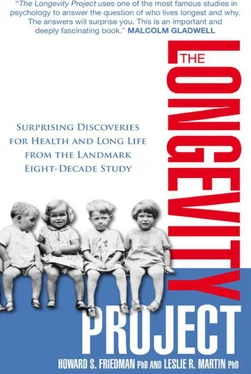We will come back to the dramatic differences we found between men and women, especially bereaved men and women, later on in the book. The lesson for now is that there are definitely times when it is very healthy to be a worrier.
If you are friendly, cooperative, trusting, and kind, then psychologists would label your personality as agreeable . This dimension—agreeableness—does a good job of summarizing the differences people have in how supportive and helpful they are. To measure the Terman participants in this way, we turned to questions they had answered about themselves in young adulthood—things like whether they tried to avoid arguments, were not critical of others, avoided hurting others’ feelings, paid attention to the feelings of others, and didn’t always try to get their own way. When describing herself in 1940, Emma indicated that she was not likely to “upbraid a workman who fail[ed] to have work done on time” nor was she likely to lose her temper, criticize others, or ignore their feelings. Instead, she saw herself as someone who was “easy to get on with.” She scored quite high on our measure of agreeableness.
While our study confirmed what other good research has shown—that agreeable, altruistic people are happier and tend to remain that way—simply being agreeable was not a secret to long life. There was certainly indication that agreeable folks stayed healthier, especially in terms of having good social relationships. But it was the social relationships themselves that turned out to be more important to physical health and long life. Being agreeable predisposed Emma to make friends and do for others but was not a direct link to her health. We’d discovered yet another case of how the importance of happiness to health is often overstated or misinterpreted. People involved in social and altruistic activities tend to be happy. But making a person happy and cheery will not necessarily make them altruistic and involved in charitable activities.
Just as worrying is not necessarily bad for your health, being agreeable is not always good for your health; it all depends on where you are on your life’s pathway and what situations you’re currently facing. That’s not to say that emotions aren’t relevant to health; rather it means you have to be a little more sophisticated and do a little more thinking about how these emotions matter for your individual case.
Shared Paths to Health and Happiness
Really tall people purchase clothes that are sized as “extra long,” but few of us would buy extra long clothes in an effort to make ourselves grow taller. Sometimes it is very clear that there are underlying causes, such as genes and good nutrition, that lead to the association between two results. Yet in the health field, we constantly go astray in our understanding of what causes what.
One of our colleagues and friends is the distinguished researcher Sonja Lyubomirsky. Sonja is a leader in studying interventions that make people happier. One day, looking over the recommendations that Sonja and other happiness researchers make about improving and maintaining happiness, we were struck by an amazing correspondence and connection: many (but not all) of the recommendations for happiness are nearly identical to recommendations for maintaining health.
For example, those trying to improve their happiness are advised to do the following things:
• Watch less TV
• Improve social relations—spend time with friends
• Increase levels of physical activity—go for a long walk
• Help others and express gratitude to those who have helped you
• Take on new challenges to remain fresh and in-the-moment
These are all connected to health and long life, but we view them differently and would reframe the process: rather than recommending that you do each of these items, our research with the Terman participants suggests finding a lifestyle in which doing each of these things comes naturally. That is, these recommended activities are part of long-term patterns that characterize healthy and happy individuals. The healthy patterns and pathways come first, and they lead to both health and happiness.
What It Means for You: Guideposts to Health and Long Life
Let’s face it, if you hear advice to stop watching your favorite television shows, put away your snacks, and go out running, you are very unlikely to do it. If you are really motivated, you might try for a while but then soon enough fall back into your old habits. But if you are the kind of person who is really, really busy with friends, family, congregation, a sports league, a challenging career, travel, book clubs, and more, then you won’t have much time to sit, snack, and watch TV.
The same is true of an artificial attempt to express gratitude to your mentors. It works (at cheering you up) in the short term but then falls by the wayside, unless it strengthens social bonds. The Terman subjects who were very happy (and many were very happy) never received formal instruction about happiness. They did not live in a land of laugh therapy, self-esteem clinics, and indulgent parents. 24 24 For a good relevant discussion of narcissism, see Jean M. Twenge, Generation Me: Why Today’s Young Americans Are More Confident, Assertive, Entitled—and More Miserable Than Ever Before (New York: The Free Press, 2006).
Instead, they traveled pathways of living that made them happy, healthy, (often) wealthy, and wise.
In fact, many knew that being happy is not the same as being healthy, and that worrying is sometimes a good thing. The Terman participants who lived long happy lives were not cynical rebels and loners. They were indeed accomplished individuals who were satisfied with their lives, but they did not pursue happiness. They were happy and laughed because they were healthy, wealthy, and wise—their happiness was a by-product of their pathways to long life. As we shall see, their particular types of social relations, careers, hobbies, and habits paved the true royal road to health.
So the reason that healthy people like Emma are happy but happy people are not necessarily healthy is that living a certain lifestyle puts you on the paths to long life that simultaneously make you happy and fulfilled; but cheering yourself up with short-term pleasures will usually do nothing remarkable for your health. Emma was not an especially cheery and optimistic child, but that didn’t interfere with her later health and happiness. If you find friends who laugh with you, then that is probably a healthy thing. If you find television shows that make you laugh all evening while you sit alone and eat, then that is not healthy. “Cheer up and live long” is much too simple—another dead-end myth.
If the same things that lead to happiness often lead to health, and the same things that improve health also boost happiness, then it should not be terribly surprising that happier folks are healthier or that tall folks wear extra long clothes. Sometimes, improving your health may improve your happiness. Sometimes, in facing very troubling times, happy people can cope well and maintain their health. But mostly, doing the right things will improve both your happiness and your health.
CHAPTER 5
Catastrophic Thinking
The Fates of Chicken Littles
If an acorn drops on your head and you conclude that the sky is falling, psychologists might call you a “catastrophizer.” There is a pattern to how people explain or interpret bad events: catastrophizers see impending doom everywhere, while sunnier types are quick to see signs of fortune in their midst. If you are the former, you might really have something to fear: this pattern may be a forewarning of increased mortality risk.
Читать дальше











